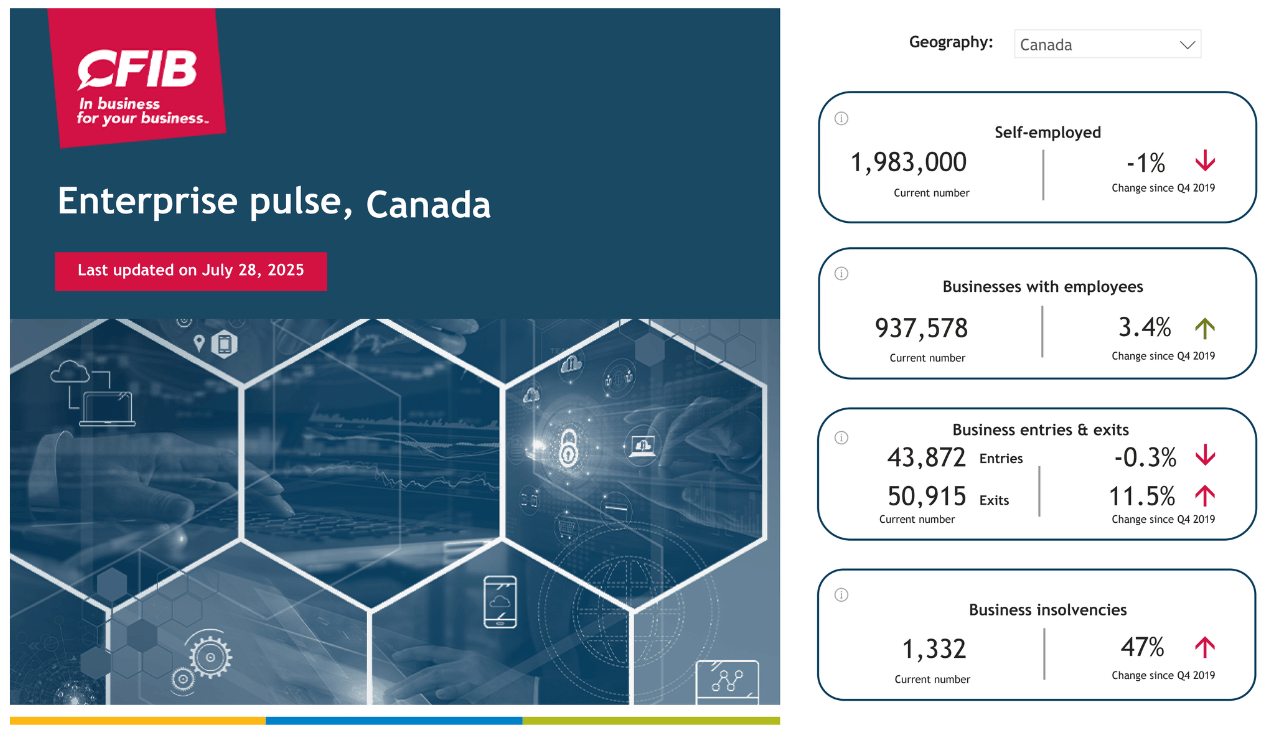
Business and entrepreneurship are at the heart of economic activity. While some firms and entrepreneurs become enduring economic success stories that may even span multiple generations, many others also animate the continuous cycle of entries, growth and exits. All this is part of what enables our economic resilience, capacity to innovate and overall progress as a nation. Therefore, tracking business and entrepreneurial activity allows us to get a fairly good assessment of Canada’s overall economic health.
CFIB’s Enterprise Pulse aims to provide this tracking through a comprehensive yet accessible picture of the business and entrepreneurial life cycle in Canada, its provinces and its industries. It presents an overview of the continuum of economic activity, from the one-person businesses (self-employed with no employees) to active businesses with employees and the churn within this category (business entries and exits), to the insolvency numbers.
The Enterprise Pulse consists of a quarterly report covering the latest update from the publicly available data, and of an interactive dashboard allowing readers to drill down using tailored visualizations. Scroll down to discover these tools.
Q1 2025
Canadian Entrepreneurship Still on Uneven Ground
|
Highlights
|
Self-employment in Canada (Q1 2025): Nearing pre-pandemic levels, but growth has slowed
Over the past four quarters, Canada has averaged approximately 1.98 million self-employed. The most recent reading (Q1 2025) is nearly on par with levels observed in Q3 2019, though still slightly below the peak of 2 million recorded in Q4 2019.
Following a sharp rebound from Q3 2023 through Q2 2024, the pace of self-employment growth has slowed considerably, showing only modest gains in recent quarters.
Self-employed, quarterly data, Canada

Note: Self-employed data presented quarterly from Q1 2015 to Q1 2025. It includes both incorporated and unincorporated self-employed without employees.
Source: Statistics Canada. Custom tabulation for CFIB.
In per capita terms, self-employment has remained virtually flat, with about 480 self-employed individuals per 10,000 people over the past year. By comparison, pre-pandemic levels averaged closer to 530 per 10,000 in the four quarters leading up to early 2020.
Self-employed per 10,000 people, quarterly data, Canada

Note: Self-employed data presented quarterly from Q1 2015 to Q1 2025. It includes both incorporated and unincorporated self-employed without employees.
Sources: Statistics Canada. Custom tabulation for CFIB.
Table 17-10-0009-01, population estimates.
Businesses with employees (Q1 2025): Growth is concentrated in few sectors only
Following two years of small gains, the number of active businesses with employees has remained almost flat during 2024 and registered a small drop in Q1 2025 compared to the previous quarter (-574). The current number represents only a 3% increase compared to Q4 2019.
On a year-over-year basis, the number of businesses with employees fell by 1,556. All but two sectors lost businesses, the most notable declines were registered in retail (-1,752), transportation (-1,315), and wholesale (-878). The only sectors that gained business were health and education (+1,169), and information, arts and recreation (+17).
Net change during the past 12 months in the number of businesses with employees, quarterly data

Note: Business with employees data presented as a change between Q1 2023 and Q1 2025.
Source: Statistics Canada.
When population is taken into account, the latest (Q1 2025) number of 226 businesses with employees per 10,000 of population is below the level registered before the pandemic of 240. The number of businesses with employees per 10,000 of population has been on a downwards trend for the past 10 years. After the abysmal level of 211 reached in 2020, the number has increased until Q2 2022 when it was back up to the pre-pandemic level of 240. However, since then, it has been following a steeper-than-before-2019 downwards trend. This may be due, in part, to the rapid population growth since 2022 and in part to the tough economic climate which has seen less business creation.
Businesses with employees per 10,000 people, quarterly data, Canada

Note: Business with employees data presented quarterly from Q1 2015 to Q1 2025.
Sources: Statistics Canada.
Table 17-10-0009-01, population estimates.
Business entries and exits (Q3 2024): Net negative for a third quarter in a row
For three consecutive quarters, the business landscape has been marked by exits surpassing entries. A similar trend was observed in the second half of 2019 and intensified during the pandemic. Since Q3 2020, Canada experienced healthy net business creation. However, the first three quarters of 2024 mark a negative net change. The number of business entries has gradually decreased since mid-2023 while the number of business exits has increased since Q4 2023.
Net change, quarterly data, Canada

Note: Net change = [Business entries] - [Business exits]. Net change data presented quarterly from Q1 2015 to Q3 2024.
Source: Statistics Canada.
Businesses insolvencies (Q1 2025): Bankruptcies and proposals remain elevated, but the trend is improving
Business insolvencies surged to alarming levels in Q1 2024, however since then, they have dropped sharply for the rest of 2024 and remained unchanged in Q1 2025. From the peak of just over 2,000 bankruptcies seen in Q1 2024, the number dropped to 1,332 in Q1 2025.
Business insolvencies, quarterly data, Canada

Note: Business insolvencies data presented quarterly from Q1 2015 to Q1 2025.
Source: ISED Canada.
Interactive Dashboard
For specific trends about the counts, the net change, and the trends over time, use our interactive dashboard below. You can see the data monthly or quarterly, for Canada, by province or sector, in absolute numbers or % change.

 Share Article
Share Article
 Print Article
Print Article
